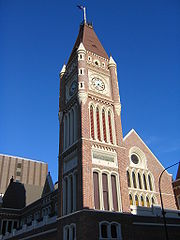
Perth Town Hall
Encyclopedia

.jpg)
Perth, Western Australia
Perth is the capital and largest city of the Australian state of Western Australia and the fourth most populous city in Australia. The Perth metropolitan area has an estimated population of almost 1,700,000....
Town Hall, situated on the corner of Hay
Hay Street, Perth
Hay Street is a major road through the CBD of Perth, Western Australia. The street was named after Robert William Hay, the Permanent Under Secretary for Colonies. Sections of the road were called Howick Street and Twiss Street until 1897...
and Barrack streets, is the only convict-built town hall in Australia
Australia
Australia , officially the Commonwealth of Australia, is a country in the Southern Hemisphere comprising the mainland of the Australian continent, the island of Tasmania, and numerous smaller islands in the Indian and Pacific Oceans. It is the world's sixth-largest country by total area...
.
Designed by Richard Roach Jewell
Richard Roach Jewell
Richard Roach Jewell was an architect who designed many of the important public buildings in Perth during the latter half of the nineteenth century....
and James Manning in the Victorian Free Gothic
Gothic Revival architecture
The Gothic Revival is an architectural movement that began in the 1740s in England...
style, the hall was built by convict
Convict
A convict is "a person found guilty of a crime and sentenced by a court" or "a person serving a sentence in prison", sometimes referred to in slang as simply a "con". Convicts are often called prisoners or inmates. Persons convicted and sentenced to non-custodial sentences often are not termed...
s and free men between 1868 and 1870. Its decorations contain a number of convict motifs, including windows in the shape of the broad arrow, and decorations in the shape of a hangman's rope.
The foundation stone for Perth Town Hall was laid on 24 May 1867 by Governor Hampton
John Hampton
John Stephen Hampton was Governor of Western Australia from 1862 to 1868.-Early life:Little is known of John Hampton's early life. His death certificate states that he was born in 1810, but other evidence suggests 1806 or perhaps 1807; these latter figures are considered more likely...
in a ceremony involving a lot of pomp and parade. However there were torrential downpours. The ceremony went on anyway with an official procession from Government House and a mock battle performed by the Volunteer Regiments, Enrolled Forces of Pensioners, and the WA Country Regiment.
In 1929, the Centenary of Western Australia
Centenary of Western Australia
In 1929, Western Australia celebrated the centenary of the founding of Perth and the establishment of the Swan River Colony, the first permanent European settlement...
one of the events in the city of Perth was the placing of a commemorative plaque in the north west corner of the building by the Governor Sir William Campion
William Campion
Colonel Sir William Robert Campion KCMG, DSO, TD, DL was a British politician and Governor of Western Australia from 1924 to 1931....
.
For many decades in the 20th century, shops were built into the sides of the ground floor, and the public lavatories accessible from Barrack Street were the only ones available for some distance. The shops included pharmacies, and lunch bars. All these businesses and the attendant structures were removed prior to the renovation of the hall.
At the time of its centenary in 1970, the ground floor was still full of commercial businesses.
The Town Hall was restored in the late 1990s at the base in an award-winning restoration
Building restoration
Building restoration describes a particular treatment approach and philosophy within the field of architectural conservation. According the U.S...
to repair the interior of the hall and the gothic
Gothic architecture
Gothic architecture is a style of architecture that flourished during the high and late medieval period. It evolved from Romanesque architecture and was succeeded by Renaissance architecture....
arch
Arch
An arch is a structure that spans a space and supports a load. Arches appeared as early as the 2nd millennium BC in Mesopotamian brick architecture and their systematic use started with the Ancient Romans who were the first to apply the technique to a wide range of structures.-Technical aspects:The...
es at its base, which were "modernised" in the middle of the 20th century.
External links
- Town Hall fact page, City of Perth
- Pre-1910 photo showing original arches (including 1980's photo showing 20th century alterations)]

